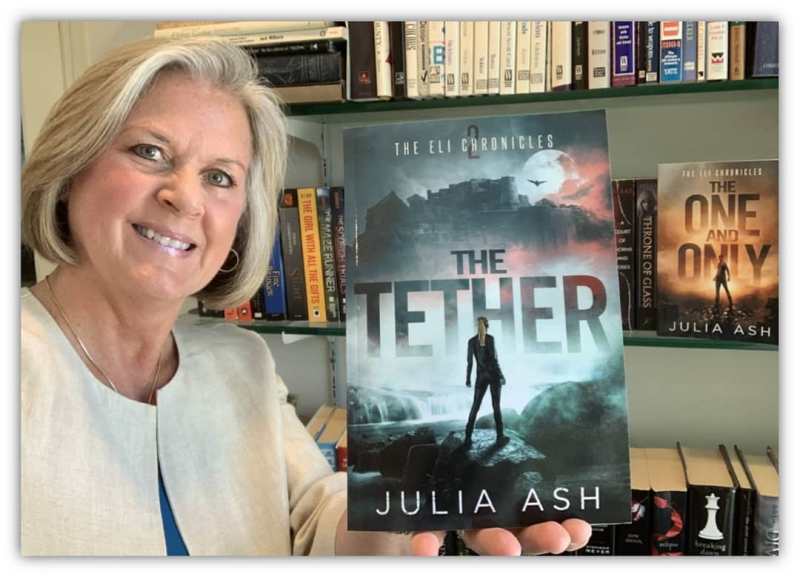
Julia Ash leapt onto the literary scene with her hit The One and Only and has recently launched its stunning sequel, The Tether. She runs an absolutely fabulous blog and can be found all across the internet.
Writing is a solitary endeavor — Julia Ash
Julia Ash graduated with distinctions for a BA in Communications from Penn State (Main Campus) before devoting nearly twenty years to her local school system. She’s contributed to education columns for Gannett newspapers and was ranked #8 in the nation as a novice Jet Ski racer.
Her passion for writing began at a young age and it came as no surprise when she decided to pursue this lifelong dream in the form of The One and Only.
Reading and writing go hand in hand. Although I spend the bulk of my workdays writing, I try to sustain my passion for reading by opening a book every night. — Julia Ash
Her first book focuses on Ruby (the aformentioned One and Only) who is the only human immune to the Zom-B outbreak. Ash expertly weaves together a complicated tale of mad scientists, a husband’s devotion, disease outbreaks, a mother’s love, and (above all) a fight for survival.
In the most recent installment of The ELI Chronicles, The Tether, Ruby (now a vampire) finds herself embroiled in a horrifyingly malicious scheme. The vampires have been observing earth for a long, long time and now that humanity’s crippled, they set their plans into motion. Will Ruby save the world? Will she even be able to save herself??
What I most admire about Ash’s books is how grounded in reality they feel. I know, it sounds odd! Zom-B, mad scientists, vampires, “aliens” and so much more – and yet the underlying characters are so solidly done that you often forget that you are in a fantasy world.
It is always a pleasure to read and review for Julia and I am so grateful to have the opportunity to interview her. Without further ado, here’s Seven Questions on a Saturday with Julia Ash!
1) What does a typical day of writing look for you? 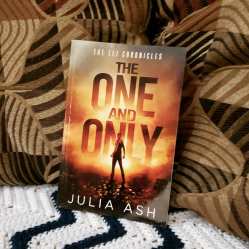
I’m an early bird. Weekdays, my alarm sounds at 5 a.m. and by 6:15 a.m., I’m on my computer, sipping a mug of hot coffee. I warm up by checking my social media accounts and responding to comments and posts. I also check my email and book sales.
Usually by 7:30 a.m., I’m writing. I don’t lift my fingers from the keyboard until noon, with the exception of a few short breaks to check social media or take my dogs outside. Every day, at least four hours are devoted to writing my novel, and sometimes, I continue this regiment on weekends.
On high energy days when my creativity is on overdrive and my characters have too much to say, I’ll write after lunch as well. But if I’m in the mood for a change of pace, I’ll switch to marketing, researching, outlining, editing, or writing an entry on my blog. There’s never been a day, since choosing writing as a second career, that I haven’t had an extensive to-do list.
My workday typically ends at 5 p.m. which is dinner time for my pups!
2) Since publishing your first book, how has your writing style or approach to writing changed with your second?
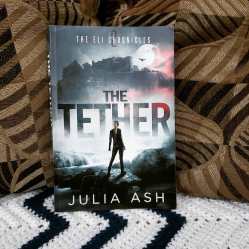 My writing style has remained the same, though I’m committed to continually improving my craft. I still write in character “voices” that are “close” to the action. Therefore, I lean toward informal, conversational prose instead of a formal style devoted to proper grammar. It isn’t that I don’t know familiar rules like sentences shouldn’t start with conjunctions or end in prepositions. However, most people think and speak informally, and I want readers to believe my characters are actually narrating their chapters.
My writing style has remained the same, though I’m committed to continually improving my craft. I still write in character “voices” that are “close” to the action. Therefore, I lean toward informal, conversational prose instead of a formal style devoted to proper grammar. It isn’t that I don’t know familiar rules like sentences shouldn’t start with conjunctions or end in prepositions. However, most people think and speak informally, and I want readers to believe my characters are actually narrating their chapters.
In comparison, my writing approach has changed in three ways from my first to my second book:
1. BACK COVER COPY: For my debut novel, The One and Only, I waited to craft my back-cover copy until after my manuscript was finished. Since my story includes several subplots, I struggled to condense The One and Only into a catchy and crisp 150-word synopsis! I kept asking myself…What do I include? What do I leave out? Now, I write my back-cover copy first, before I start writing my manuscript! This allows me to stay focused on the main plot. I think this strategy has strengthened the all-important back-cover “teaser.” I mean, who doesn’t read a paperback’s cover copy or a hardcover’s inside flap when considering a book? (Okay, so there are probably a few people!)
2. FIRST CHAPTER: The hook and first chapter are critical, as book vendors typically let would-be purchasers take an inside peek at them. Readers need to learn the main character’s personal problem/challenge/conflict as early as possible, so they are inspired to read on. The One and Only presents Ruby’s personal problem at the end of Chapter 4 (she’s going to be kidnapped), which is still early-ish. But in The Tether, the last line of Chapter 1 already hints that rough times are imminent:
“A shudder raced down her spine. Something was coming. But she didn’t know what…or who.”
3. CHARACTERIZATION: My novels are written with multiple points of view, told by my main cast of characters. It can be challenging to integrate each character’s unique personality and voice without falling into the blah-ba-blah trap of too much backstory. I think I avoided this pitfall in my first book, it’s just that I believe my skills for fleshing out distinct characters, whom readers quickly care about (or love to hate), have improved.
3) Names are sometimes the hardest decision for writers while others pick them out of a hat. Do you find naming difficult? Could you explain why or how you chose the names of your main characters in your books?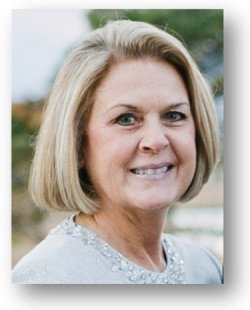
I love finding names that serve a double duty, so no hat picking for me! Most of the names I choose align with a character’s personality while connecting to the plot.
My main character Ruby is named after the ruby gemstone, symbolizing protection, vitality (blood), love, courage, and royalty. Some believe rubies, not diamonds, are the most powerful stones in the universe. The name fits Ruby perfectly because in The One and Only, her unique blood protects humankind from the first wave of the bioweapon’s infection. In The Tether, she learns she’s inherited powerful gifts via a blood transfusion in utero. Most importantly, if those competencies are awakened, she has the capacity to defeat the most odious force Earth will ever encounter.
The villain in The Tether is named Zagan, meaning fallen angel. Because of his foolish resistance to abide by an oracle’s directive, he becomes cursed. The awareness of evil locks within his soul. And sadly, the once adventurous and passionate vampire quickly morphs into the King of Darkness.
Most of my world-building locations also have intentional names. Athanasia—the planet of vampires—means “immortality.” The planet where animals originate is called Besto Polus, which translates to “numerous animals.”
Although most of the names in my books are purposeful, some were selected because they sounded good. My primary villain in The One and Only, for example, is named Lieutenant Colonel Quinton Oxford, nicknamed Ox. I don’t think I could’ve picked a better name!
For each book, I make a chart of the alphabet and list characters under the beginning letter of their first name. Have you ever read a book with characters and locations which have similar sounding names like Dara, David, and Dani who all live in Danbury? Name alliteration can be very confusing for readers, so I try to avoid this.
4) Could you give an example of something you edited out of The Tether or The One and Only? What made you decide that that “had to go”?
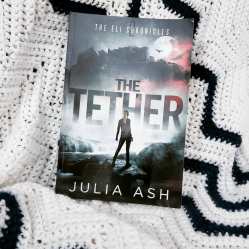 Let’s face it, writers love to write. Sometimes we fall in love with sentences, paragraphs, and even scenes which sound lovely or fun or scary, but which fall short of moving the story forward or endearing readers to characters. These extraneous add-ons slow pacing. So, the fluff has to go.
Let’s face it, writers love to write. Sometimes we fall in love with sentences, paragraphs, and even scenes which sound lovely or fun or scary, but which fall short of moving the story forward or endearing readers to characters. These extraneous add-ons slow pacing. So, the fluff has to go.
I try not to save my text cuts. However, here’s an example of two sentences in Chapter 1 of The Tether that I loved but decided to chop:
A flock of starlings lifted from nearby trees, rising like a black feathered blanket. Their chirps faded in the distance as the birds flew to safety ahead of the storm.
Editing can pull at your heartstrings. Finding objective eyes is a must. After I polish my manuscript, I submit it to a professional editor. Kerrie helps me identify the fluff I’ve missed. And my beta readers also provide valuable feedback.
5) Now that The Tether and The One and Only are published, what advice do you have for new authors trying to market their books? Any traps or pitfalls to avoid?
My marketing advice is to use social media as an engagement tool.
Engagement is a buzzword that is often misunderstood. Engagement requires action between two parties. If I (the author) place a post on Facebook and it receives two likes from my friends/followers, engagement is low. If, however, I receive 50 to 200+ likes on FB, engagement is much healthier. (Engagement expectations can vary across platforms and is affected by the number of friends following the author’s page.)
I have found that the best formula for engagement is to focus on quality posts, not quantity. Have you ever noticed the users who post every hour of every day? Look at their engagement stats for each post. Chances are they’re low. (Of course, some debunk this generalization, especially celebrities.)
Have you ever noticed users who constantly post the same types of messages, like inspirational sayings or photos of themselves every hour? Engagement is probably low.
I post less often (like one to three times a week) and vary the posts based on what inspires my friends to engage. I may start my posting cycle with something about my book. Days later, something about my dogs. I might finish the cycle by posting something personal, like a photo of myself at my favorite location with a blurb about why I’m there. Over time, I’ve learned what my friends are interested in—what engages them.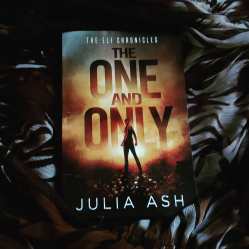
Social media (as an engagement tool for authors) should not be about the author’s likes (unless you truly are posting for your own pleasure). Posting should always be about inspiring your friends. Think about it: if a post’s engagement is low, what’s the point? It would be like holding a concert without having an audience motivated to go to it!
One more piece of advice: if a friend (or potential friend) comments on a post or tweet or Goodreads review, the message has sparked higher-level engagement which requires Newton’s third law! Every action “should have” an equal and opposite reaction. Meaning, every comment should receive an author’s response, even if it’s a simple thank you.
Social media is reciprocal. Its purpose is engagement. Engagement builds bonds. Bonds build friendships. And friends read books!
In terms of general advice for aspiring authors, I recommend learning about novel structure before ever starting to write. Why? Because I wrote a 99k-word novel before I understood that novel writing has a specific structure (regardless of genre) that requires ten plot-points. And the plot-points should occur at pretty specific times in your novel. No surprise that my first manuscript is collecting dust!
I tell aspiring authors that writing without understanding structure would be like building a house without blueprints or incorporating specific load-bearing walls. The house wouldn’t meet code and would probably implode on itself. Or…try moving a foundation, kitchen, or stairway after the house has been built. Yikes!
My favorite book on novel structure is by K.M. Weiland and it’s titled Structuring Your Novel.
6) Your books contain many fantastical elements (zombies, vampires, outer space, etc), did you always intend on having such a blended world or is this something that developed as you write? Did you run into any unexpected difficulties combining such vastly different beasts?
I have often thought about why I’m drawn to fantastical elements and literary monsters! Because in every other aspect of my life, I consider myself a realist or pragmatist. If you ask me the time, I’ll say it’s 12:03 p.m. When I fly on a plane, I literally sense that I’m 35,000 feet in the air. And I never, ever forget I’m living on a planet within a spiral galaxy of stars called the Milky Way.
Yet, the fantastical intrigues me and I intentionally include literary monsters in my storytelling, probably for two reasons.
First, everything imagined will likely be created someday—on purpose or as a consequence of a scientific or technological innovation. At one time, computers and artificial intelligence were considered fantastical. Now, we can no longer imagine life without them.
Secondly, I’m cautious about what I call “dark science.” Just because we can do something scientifically or technologically, it doesn’t mean we should.
Two examples in my writing, without giving too much away…
In The One and Only, the zombies are human victims of a bioweapon intended to decimate the animal population and starve humankind, making people dependent on China’s manufactured protein product. But the bacterium unexpectedly mutates in animal carcasses and transfers back to humans as Zoonosis Mutated Bacteria, or ZOM-B: an unexpected consequence that results in the first Extinction Level Infection (ELI).
In The Tether, the mad scientist Emory Bradshaw attempts lateral gene transfer between a naked mole rat (the only species on Earth resistant to cancer) and the First Lady, who has stage-four ovarian cancer. Readers will learn how his genetic tampering works out in my third installment in the series, The Turning Point!
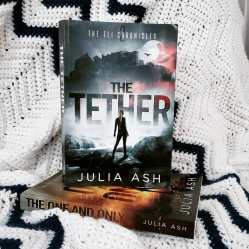 In other words, my stories are cautionary tales of what can happen if we’re careless in our application of scientific innovation. I’ve used fantastical monsters to demonstrate the possible consequences of dark science.
In other words, my stories are cautionary tales of what can happen if we’re careless in our application of scientific innovation. I’ve used fantastical monsters to demonstrate the possible consequences of dark science.
In movies, I Am Legend and I, Robot are films that speak to me! In books, The Passage by Justin Cronin and The Girl with All the Gifts by M. R. Carey touch on similar themes.
By the way, I’ll be introducing a new fantastical creature in my third installment 🙂
There have been difficulties in using these literary monsters in my books, but the reasons are not related to their combination within the same novel.
When I first marketed The One and Only to literary agents in hopes of publishing via a traditional pathway, I was told several times that my fantastical monsters were out of vogue. I could’ve shelved my projects until the tropes came back into favor (like bellbottom pants came back as flares), but I decided to move forward. Sometimes stories and characters feel like they can’t wait.
Bottomline, when it comes to storytelling, I’m not very pragmatic at all 🙂
7) According to your blog, you were raised in a haunted house. Have you ever experienced any spooky events? And if so, do you think you will use it in your books (or have you already)?
Oh, yaaas! I have a paranormal thriller or memoir begging to be told someday!
My family moved into Bleeker Hall in West Chester, Pennsylvania, when I was seven years old. Our historical home was built in 1869 and unbeknownst to us, it came with at least one ghost. The primary ghost haunting the house is named Mrs. Pinkerton (I used the present tense because I’m sure she’s still there). As we learned, she had temporarily moved to a carriage house on the property while the main house was getting electricity. Well, she died before the job was completed. Ever since, she’s been haunting the main house. My Mom managed to visit the last Bleeker to have lived in the home. She confirmed the identity of the main ghost and shared her history.
For 16 years (counting my summers in between college), my family and I (and many of our friends) faced spooky events a lot: doors slamming, lights turning on, items moving, items being thrown, foul odors, and even scarier happenings. As beautiful as the house is architecturally, I have never missed it. I’ve lived ghost-free since I moved out after college; that’s exactly the way I like it 🙂 (Note: my parents no longer own the house.)
In The Tether, Zagan appears as a ghost in two scenes. I used my experiences, for example, to describe the temperature drop associated with a ghost manifesting itself.
When I decide to write a book incorporating my experiences while living in my childhood home, I hope readers will be able to feel what I felt.
Intere
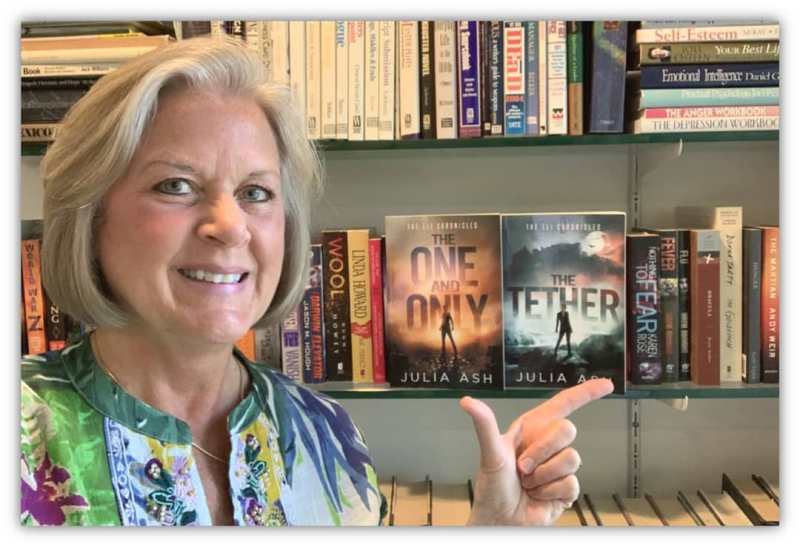
Interested in connecting with Julia Ash? Check out her social media! Website | Facebook | Twitter | Instagram | Amazon Author Page | Goodreads Author Page | Kirkus Author Page
Interested in her books? Check them out!
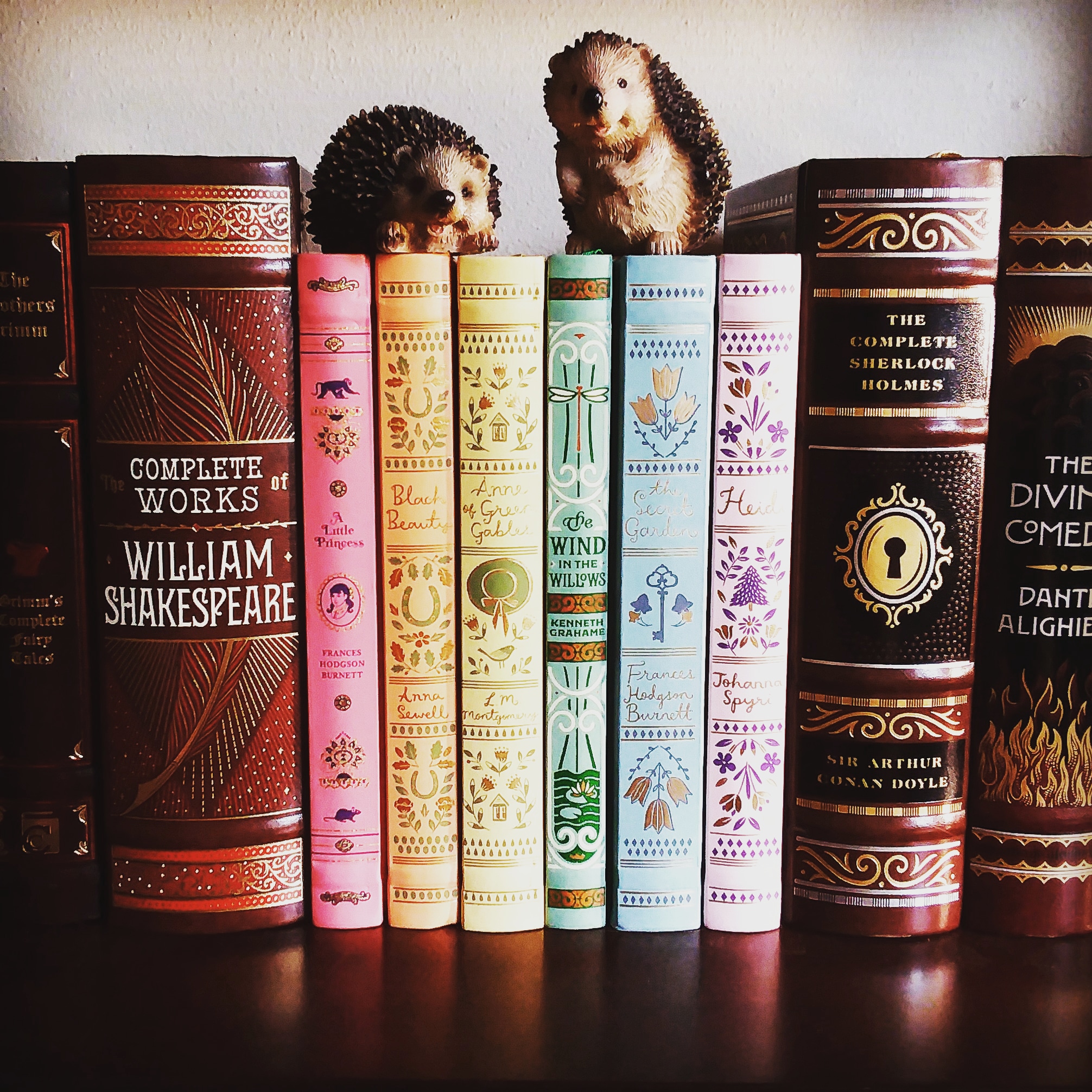

Thank you so much for interviewing me, Miranda! Such an honor! I am truly grateful! 🙂
LikeLiked by 2 people
Thank you so much for agreeing to be interviewed! It was such a pleasure!
LikeLiked by 2 people
Fantastic post. A great service to the writing and reading communities.
LikeLiked by 2 people
Awww thank you 🙂
It is SO much fun to interview authors – there’s so much to learn!
LikeLiked by 2 people